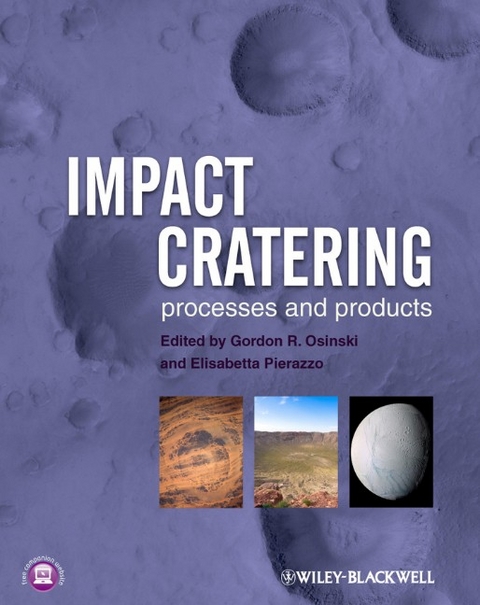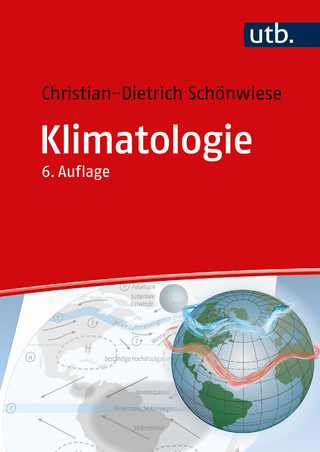
Impact Cratering
Wiley-Blackwell (Verlag)
978-1-4051-9829-5 (ISBN)
- Lieferbar (Termin unbekannt)
- Versandkostenfrei
- Auch auf Rechnung
- Artikel merken
Impact cratering is arguably the most ubiquitous geological process in the Solar System. It has played an important role in Earth’s history, shaping the geological landscape, affecting the evolution of life, and generating economic resources. However, it was only in the latter half of the 20th century that the importance of impact cratering as a geological process was recognized and only during the past couple of decades that the study of meteorite impact structures has moved into the mainstream. This book seeks to fill a critical gap in the literature by providing an overview text covering broad aspects of the impact cratering process and aimed at graduate students, professionals and researchers alike. It introduces readers to the threat and nature of impactors, the impact cratering process, the products, and the effects – both destructive and beneficial. A series of chapters on the various techniques used to study impact craters provide a foundation for anyone studying impact craters for the first time.
Dr Gordon "Oz" Osinski is the NSERC/MDA/CSA Industrial Research Chair in Planetary Geology in the Departments of Earth Sciences and Physics and Astronomy at Western University, Canada. He holds a B.Sc. (Hons) First Class in Geology from the University of St. Andrews, Scotland (1999) and a Ph.D., also in Geology (2004), from the University of New Brunswick, Canada. His research covers the tectonics of impact crater formation, the generation of impact melts, emplacement of ejecta, and post-impact processes such as impact-associated hydrothermal activity. He has published more than 70 papers in peer-reviewed journals and special papers and has given over 60 conference presentations since 2001. Dr Elisabetta Pierazzo, who tragically died during the preparation of this book, was a Research Scientist at the Planetary Science Institute and an Adjunct Assistant Research Scientist at the Lunar & Planetary Laboratory, University of Arizona, both located in Tucson, Arizona. She held a Laurea in Physics from the University of Padua, Italy (1988) and a Ph.D. in Planetary Sciences from University of Arizona (1997). She was a world renowned expert on the numerical modelling of impact events, focusing on the environmental effects of impact events, oblique impacts, and impact melt production.
Preface xi
List of contributors xii
1 Impact cratering: processes and products 1
Gordon R. Osinski and Elisabetta Pierazzo
1.1 Introduction 1
1.2 Formation of hypervelocity impact craters 3
1.3 Morphology and morphometry of impact craters 8
1.4 Impactites 12
1.5 Recognition of impact craters 14
1.6 Destructive effects of impact events 15
1.7 Benefi cial effects of impact events 15
1.8 When a crater does not exist: other evidence for impact events 16
1.9 Concluding remarks 16
References 17
2 Population of impactors and the impact cratering rate in the inner Solar System 21
Patrick Michel and Alessandro Morbidelli
2.1 Introduction 21
2.2 Population of impactors in the inner Solar System 22
2.3 Impact frequency of NEOs with the Earth 24
2.4 Comparison with the impact record on terrestrial planets 25
2.5 Variability of the impact frequency during the last 3 Ga 26
2.6 The early cratering history of the Solar System 27
2.7 Conclusions 28
References 29
3 The contact and compression stage of impact cratering 32
H. Jay Melosh
3.1 Introduction 32
3.2 Maximum pressures during contact and compression 35
3.3 Jetting during contact and compression 37
3.4 The isobaric core 38
3.5 Oblique impact 39
3.6 The end of contact and compression 40
References 42
4 Excavation and impact ejecta emplacement 43
Gordon R. Osinski, Richard A. F. Grieve and Livio L. Tornabene
4.1 Introduction 43
4.2 Excavation 43
4.3 Impact plume 46
4.4 Generation of continuous ejecta blankets 47
4.5 Rayed craters 51
4.6 Generation of multiple ejecta layers 52
4.7 Distal impact ejecta 56
4.8 Depth of excavation 57
References 57
5 The modification stage of crater formation 60
Thomas Kenkmann, Gareth S. Collins and Kai Wünnemann
5.1 Introduction 60
5.2 Morphology and morphometry of simple and complex impact craters 62
5.3 Kinematics of crater collapse 64
5.4 Subsurface structure of complex impact craters 66
5.5 Mechanics of cavity collapse: what makes the target so weak? 69
5.6 Effects of oblique impact incidences on cavity collapse 71
5.7 Effects of rheologically complex targets on cavity modifi cation 71
References 73
6 Impact-induced hydrothermal activity 76
Kalle Kirsimäe and Gordon R. Osinski
6.1 Introduction 76
6.2 Formation and development of the post-impact thermal field 76
6.3 Composition and evolution of the hydrothermal fluids and mineralization 79
6.4 Implications for extraterrestrial impacts and microbial life 85
References 87
7 Impactites: their characteristics and spatial distribution 90
Richard A. F. Grieve and Ann M. Therriault
7.1 Introduction 90
7.2 Autochthonous impactites 90
7.3 Parautochthonous impactites 91
7.4 Allochthonous impactites 92
7.5 Concluding remarks 101
References 102
8 Shock metamorphism 106
Ludovic Ferrière and Gordon R. Osinski
8.1 Introduction 106
8.2 Shock metamorphic features 108
8.3 Post-shock thermal features 119
8.4 Concluding remarks 120
References 121
9 Impact melting 125
Gordon R. Osinski, Richard A. F. Grieve, Cassandra Marion and Anna Chanou
9.1 Introduction 125
9.2 Why impact melting occurs 125
9.3 Terrestrial impact melt products 126
9.4 Planetary impact melt products 139
9.5 Impactor contamination 141
9.6 Concluding remarks 142
References 142
10 Environmental effects of impact events 146
Elisabetta Pierazzo and H. Jay Melosh
10.1 Introduction 146
10.2 The impact hazard 146
10.3 The impact cratering process 147
10.4 Shock wave effects 148
10.5 Ejecta launch 150
10.6 Long-term atmospheric perturbation 151
10.7 The response of the Earth system to large impacts 152
10.8 Environmental impact effects favourable for life 153
10.9 Concluding remarks 153
References 154
11 The geomicrobiology of impact structures 157
Charles S. Cockell, Gordon R. Osinski and Mary A. Voytek
11.1 Introduction 157
11.2 Physical changes 158
11.3 Chemical changes 165
11.4 Impact events and weathering 166
11.5 Impoverishment or enrichment? 171
11.6 Astrobiological implications 172
11.7 Concluding remarks 172
References 172
12 Economic deposits at terrestrial impact structures 177
Richard A. F. Grieve
12.1 Introduction 177
12.2 Progenetic deposits 177
12.3 Syngenetic deposits 182
12.4 Epigenetic deposits 186
12.5 Hydrocarbon accumulations 186
12.6 Concluding remarks 189
References 190
13 Remote sensing of impact craters 194
Shawn P. Wright, Livio L. Tornabene and Michael S. Ramsey
13.1 Introduction 194
13.2 Background 194
13.3 Photogeology 196
13.4 Morphometry, altimetry, topography 196
13.5 Composition derived from remote sensing 196
13.6 Physical properties derived from remote sensing 201
13.7 General spectral enhancement and mapping techniques 202
13.8 Case studies 203
13.9 Concluding remarks 207
References 207
14 Geophysical studies of impact craters 211
Joanna Morgan and Mario Rebolledo-Vieyra
14.1 Introduction 211
14.2 Geophysical signature of terrestrial impacts 211
14.3 The resolution of geophysical data 215
14.4 Modelling geophysical data 216
14.5 Case studies 217
References 220
15 Projectile identification in terrestrial impact structures and ejecta material 223
Steven Goderis, François Paquay and Philippe Claeys
15.1 Introduction 223
15.2 Current situation: projectile identification at impact craters and ejecta layers 223
15.3 Methodology 226
15.4 Review of identified projectiles 234
15.5 Concluding remarks 235
References 235
16 The geochronology of impact craters 240
Simon P. Kelley and Sarah C. Sherlock
16.1 Introduction 240
16.2 Techniques used for dating terrestrial impact craters 241
16.3 Impact craters at the K–Pg boundary 246
16.4 Geochronology of impacts, flood basalts and mass extinctions 247
16.5 Using geochronology to identify clusters of impacts in the geological record 248
16.6 Concluding remarks 250
References 251
17 Numerical modelling of impact processes 254
Gareth S. Collins, Kai Wünnemann, Natalia Artemieva and Elisabetta Pierazzo
17.1 Introduction 254
17.2 Fundamentals of impact models 256
17.3 Material models 262
17.4 Validation, verifi cation and benchmarking 267
17.5 Concluding remarks 267
References 268
18 Comparison of simple impact craters: a case study of Meteor and Lonar Craters 271
Horton E. Newsom, Shawn P. Wright, Saumitra Misra and Justin J. Hagerty
18.1 Introduction 271
18.2 Meteor Crater, Arizona 271
18.3 Lonar Crater 274
18.4 Comparisons and planetary implications 283
18.5 Summary and concluding remarks 285
Acknowledgements 285
References 286
19 Comparison of mid-size terrestrial complex impact structures: a case study 290
Gordon R. Osinski and Richard A. F. Grieve
19.1 Introduction 290
19.2 Overview of craters 290
19.3 Comparisons and implications 301
19.4 Comparisons with lunar and Martian impact craters 302
19.5 Concluding remarks 303
References 303
20 Processes and products of impact cratering: glossary and definitions 306
Gordon R. Osinski
20.1 Introduction 306
20.2 General definitions 306
20.3 Morphometric definitions and equations 307
20.4 Impactites 308
References 308
Index 310
| Erscheint lt. Verlag | 30.11.2012 |
|---|---|
| Verlagsort | Hoboken |
| Sprache | englisch |
| Maße | 226 x 283 mm |
| Gewicht | 1293 g |
| Themenwelt | Naturwissenschaften ► Geowissenschaften ► Allgemeines / Lexika |
| Naturwissenschaften ► Geowissenschaften ► Geologie | |
| ISBN-10 | 1-4051-9829-X / 140519829X |
| ISBN-13 | 978-1-4051-9829-5 / 9781405198295 |
| Zustand | Neuware |
| Haben Sie eine Frage zum Produkt? |
aus dem Bereich


